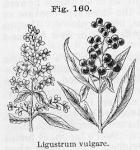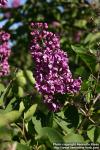
 The leaves of Ligustrum vulgare, Linné.
The leaves of Ligustrum vulgare, Linné.
Nat. Ord.—Oleaceae.
COMMON NAMES: Privet, Privy, Prim.
Botanical Source.—This plant is a smooth shrub, growing 5 or 6 feet high, with wand-like branches. The leaves are dark-green, 1 or 2 inches in length, about half as wide; opposite, entire, smooth, lanceolate, and obovate, obtuse, or acute, and borne on short petioles. The flowers are small, numerous, white, in tetramerous, thyrsoid, terminal panicles. The calyx is minutely 4-toothed, deciduous, and short-tubular; the corolla funnel-form, tube short, limb with 4 spreading, ovate, obtuse lobes. The stamens are 2, on the tube of the corolla; the anthers large and exserted. Style very short; stigma 2-cleft. Berries spherical, black, in conical bunches, 2-celled, from 2 to 4-seeded; seeds convex on one side, angular on the other (W.—G.).
History, Description, and Chemical Composition.—Privet is found growing wild in woods and thickets, and along the roadsides from New England to Virginia, and west to Missouri, flowering in May and June. It is used in England for hedges, from which place it is supposed to be introduced; but it is indigenous in Missouri. It is often cultivated in gardens. The leaves are the medicinal parts; they have but little odor, and an agreeable, bitterish, and astringent taste; they yield their virtues to water or alcohol. The flowers have been employed for similar purposes with the leaves. The berries have a sweetish-bitter taste, are reputed cathartic, and to render the urine brown; they have been used for dyeing. Probably the bark will be found equal if not superior in efficacy to the leaves. M. G. Polex (1841) found the bark to contain sugar, mannit, starch, bitter resin, and a peculiar substance which he called ligustrin, which has since been shown by Kromayer (Archiv der Pharm., 1863, Vol. CLXIII, p. 19), to be identical with syringin (C19H28O10.H2O), a crystallizable glucosid occurring in our common lilac (see Related Species). It is odorless and tasteless, soluble in hot water and alcohol, insoluble in ether. Kromayer found, in addition, a bitter crystalline body named by him ligustron, soluble in water, alcohol, and ether. A third principle, amorphous and of bitter taste, syringopikrin, probably also occurs in the bark of ligustrum. (For details regarding the chemistry of these substances, see Husemann and Hilger, Pflanzenstoffe, 1884, p. 1273.)
Action, Medical Uses, and Dosage.—Privet leaves are astringent; a decoction of them is very valuable in chronic bowel complaints, ulceration of stomach and bowels, as a gargle for ulcers of mouth and throat, for which it is peculiarly effective, and as an injection for ulcerated ears, with offensive discharges, leucorrhoea, gleet, and ulceration of the bladder, likewise in diabetes. They may be employed either in decoction or powder. Dose of the powdered leaves, from 30 to 60 grains, 3 times a day; of the decoction, from 2 to 4 fluid ounces.
Specific Indications and Uses.—Aphthous sore mouth; sore throat.
 Related Species.—Syringa vulgaris, Common lilac. A well-known shrub, the fruit and leaves of which are bitterish and sub-acrid. Besides a sweet principle Petroz and Robinet found a bitter glucosid (C19H28O10.H2O, Kromayer, 1863), the lilacin of Meillet, and syringin of Bernays, and identical with the ligustrin of Polex. This body, when pure, is not bitter, but tasteless (see Ligustrum above). Dilute acids split it into sugar and syringenin (C13H18O5), an amorphous, pale, rose-colored mass soluble in alcohol, but not in ether and water. The fruit and leaves are antiperiodic and tonic.
Related Species.—Syringa vulgaris, Common lilac. A well-known shrub, the fruit and leaves of which are bitterish and sub-acrid. Besides a sweet principle Petroz and Robinet found a bitter glucosid (C19H28O10.H2O, Kromayer, 1863), the lilacin of Meillet, and syringin of Bernays, and identical with the ligustrin of Polex. This body, when pure, is not bitter, but tasteless (see Ligustrum above). Dilute acids split it into sugar and syringenin (C13H18O5), an amorphous, pale, rose-colored mass soluble in alcohol, but not in ether and water. The fruit and leaves are antiperiodic and tonic.

